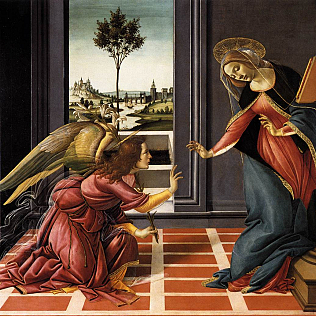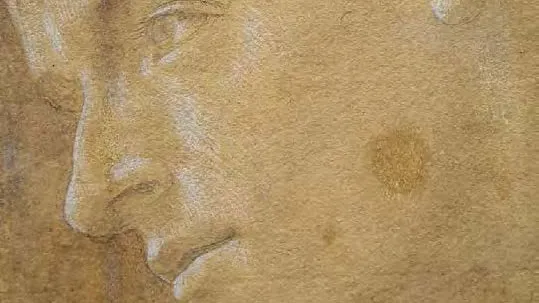Legion of Honor
November 18, 2023–February 11, 2024
A quintessential artist of the Italian Renaissance, Alessandro di Mariano di Vanni Filipepi—better known as Sandro Botticelli—has had an enduring influence on contemporary culture, from art and design to dance, music, fashion, and film. Known for some of the world’s greatest paintings, from La Primavera (1477–1482) to the Birth of Venus (1485–1486), Botticelli has inspired the likes of artists Andy Warhol, Jean Paul Gaultier, and Cindy Sherman, among others. He was an expert draftsman, creating drawings that underlie and animate his greatest compositions.
Although key to the aesthetic driving his continued relevance and popularity, there has been no major exhibition dedicated to Botticelli’s art of drawing—until now. Reuniting rare works from across the United States and Europe, Botticelli Drawings—presented exclusively at the Legion of Honor—is the first exhibition to explore the central role that drawing played in Botticelli’s art and workshop practice.
Anchored by extensive research by Furio Rinaldi, curator of prints and drawings at the Fine Arts Museums of San Francisco, the exhibition unveils five newly attributed drawings alongside nearly 60 works from 42 lending institutions.
Thorough research undertaken by Fine Arts Museums’ curator Furio Rinaldi in preparation for Botticelli Drawings has led to several new attributions to this quintessential artist of the Italian Renaissance, three of which are announced here for the first time, including preparatory drawings for renowned paintings
The Cestello Annunciation (1489, Uffizi Gallery),

Adoration of the Magi (c. 1470-1475, National Gallery of Art, Washington, D.C.), and Virgin and Child with the Young Saint John the Baptist (c.1468-70, Louvre Museum) (below). The latter painting will be on view alongside its newly attributed preparatory drawing in the upcoming exhibition.
Furio Rinaldi, Curator of Drawings and Prints at the Fine Arts Museums of San Francisco, has made a number of new attributions throughout the course of his extensive research in the lead up to the exhibition. Of those, two were executed in preparation for celebrated early paintings Adoration of the Magi (c. 1470-1475) and Virgin and Child with the Young Saint John the Baptist (c.1468-70), the latter on loan for the exhibition from the Louvre Museum. These two drawings from the historic graphic collection of Christ Church Picture Gallery, Oxford–
Head of a man in near profile looking left, here attributed to Sandro Botticelli. c. 1468-70. Traces of black chalk, metalpoint (lead?) heightened with white and grey wash, on yellow-ochre prepared paper, 13.2 x 11 cm. (Christ Church Picture Gallery, Oxford)
Head of a man in near profile looking left and Head of a woman looking down to the left–are reintroduced here with an attribution to Botticelli on the basis of technical and stylistic analysis, and connections to these early paintings by him.
Drawn in the same technique and of similar size, the drawings were likely cut from the same ochre-yellow prepared sheet of paper, and are both currently filed as anonymous 15th-century works at Christ Church. The study of the woman can be linked with the head of the Virgin, tenderly looking down in near profile to her child, in the latter painting, while the young man can be connected with the third onlooker on the right in the former. Both drawn delicately in metalpoint with selective use of heightening in white lead, the two facial types on the Oxford sheets were adapted by Botticelli in other early works, who repurposed and repeated his graphic designs in a way that would become customary for his workshop, as will be revealed in the exhibition at the Legion of Honor.
The third sheet newly attributed to Botticelli comes to the exhibition from the graphic holdings of the Uffizi Gallery, the Gabinetto Disegni e Stampe degli Uffizi, and depicts two lively studies for a head of a youth in profile. It is reintroduced here as a match with the profile of the Archangel Gabriel in the celebrated Cestello Annunciation, painted by Botticelli in1489, and also within the collection of the Uffizi. Executed on yellow-ochre prepared paper in metalpoint, these studies accord closely with the shadows and fall of light on the figure in the painting, who is shown with his mouth open while speaking to the Virgin Mary. As one of the most prolific portrait artists of his time, Botticelli had a particular interest in executing precise, evocative head studies, which represent a relatively large proportion of his body of surviving drawings. Indeed, his portraits have endured through centuries as potent symbols of beauty.
“I am thrilled to share my new findings, to be fully unveiled in our Botticelli Drawings exhibition in November," noted Furio Rinaldi. "Exhibitions like this one represent an invaluable tool for art historical investigation. I am grateful to our colleagues Jacqueline Thalmann at Christ Church Picture Gallery and Eike Schmidt at the Gallerie degli Uffizi for facilitating my research during challenging times between 2020 and 2021. These new proposed attributions will help lay the groundwork for a fuller understanding of Botticelli’s artistic output and the field of Italian Renaissance art at large."
“Furio Rinaldi, the Fine Arts Museums’ Curator of Drawings and Prints, has done exceptional research in the years leading up to our Botticelli exhibition, which in itself promises to be a groundbreaking presentation on the centrality of draftsmanship to this world-renowned artist’s practice,” remarked Thomas P. Campbell, Director and CEO of the Fine Arts Museums of San Francisco. “We are pleased to share just some of the fruits of that close and careful scrutiny now, with the announcement of three drawings newly attributed to Botticelli by Rinaldi. These works will be on view at the Legion of Honor come November, one of them alongside the celebrated painting with which it corresponds–the Louvre’s Virgin and Child with the Young Saint John the Baptist (c.1468-70).”
Pairing Botticelli’s graphic output as a whole from the Gallerie degli Uffizi, Florence; British Museum, London; and The Morgan Library & Museum, New York alongside key paintings on loan from The National Gallery, London; the Galleria Borghese, Rome; and the Musée du Louvre, Paris, Botticelli Drawings offers a rare opportunity to explore the artistic process behind such renowned works as The Adoration of the Magi (1475–1476), reunited here with three preparatory designs.
“Botticelli’s paintings are world-renowned for their grace and exquisite line, but the relationship between his drawings and paintings has never been fully investigated,” remarked Thomas P. Campbell, Director and CEO of the Fine Arts Museums of San Francisco. “Now, in this stunning and groundbreaking exhibition, the majority of Botticelli’s graphic output takes us below the surface of the paintings to illuminate the artist’s creative process, from conception and development to final execution.”
The art of drawing underwent major functional changes and technical advancements in 15th-century Florence. Among the first artists to make draftsmanship central to his aesthetic and design practice, Botticelli developed a new visual style for the era, elevating the line as the primary force behind his figures and their rhythmic movement. Striking a delicate balance between realistically portraying individual subjects and abstracting their features, Botticelli created portraits that have endured through centuries as potent symbols of beauty.
A prolific portraitist, he made a practice of drawing from life, one that would become an artistic standard in Renaissance Florence and beyond. Yet despite the centrality of drawing to Botticelli’s work, less than three dozen confirmed drawings by the artist survive today. The hardships he experienced later in life, including penury and the decline of his workshop business, may have led to the loss of the vast majority of Botticelli’s graphic output.
Botticelli Drawings features 27 drawings by the artist, exploring the medium as his primary form of artistic expression. The incredible rarity and fragility of these works precludes frequent travel, and many are leaving their lending institutions for the very first time in modern history solely for this exhibition.
The result of original, exacting research, the exhibition unveils five newly attributed drawings by Botticelli. The preparatory drawing for the
Louvre’s The Virgin and Child with the Young Saint John the Baptist (ca. 1468–1480), newly attributed, is reunited here with the resulting painting.
Other unprecedented pairings, such as the brush drawings on linen—divided between the Fitzwilliam Museum in Cambridge, England, and the Morgan Library & Museum in New York—with the resulting painting of The Adoration of the Magi (1475–1476, Uffizi), offer insight into the artist's transformative method of composition and design process.
Departing from the standard interpretation of Botticelli’s later years as a period of decline marred by successive political upheavals in the wake of the Medici’s ouster, the exhibition rethinks the artist’s works from the 1490s and 1500s as one of his most experimental phases yet. The Museums’ presentation will offer a new lens through which to consider the artist’s unconventional stylistic evolution toward linear abstraction, resistance to perspective, and anti-naturalism.
“Botticelli Drawings reunites this beloved artist’s graphic output as a whole for the very first time, a challenging endeavor given the rarity and fragility of these works,” noted Furio Rinaldi. “42 public and private institutions have staunchly supported this exhibition with unique loans, contributing drawings from their collections, the majority of which have never before left their lending institutions. This exhibition offers a truly unique opportunity to see and understand Botticelli’s thought and design process leading to the making of his memorable masterpieces.”
The exhibition is accompanied by a richly illustrated catalog (copublished by the Fine Arts Museums of San Francisco and Yale University Press) by organizing curator Furio Rinaldi, offering the first systematic study of Botticelli’s graphic output and the underdrawing of his paintings. Botticelli Drawings is a celebration of the artist’s quest for the perfect line, expressing the centrality of draftsmanship in the history of human creativity.
About Sandro Botticelli
One of the world’s most famous and beloved artists, Alessandro di Mariano di Vanni Filipepi (Florence, ca. 1445–1510), known as Sandro Botticelli, epitomizes the flowering of the Renaissance in 15th-century Italy. Botticelli established his reputation and prosperous business from the late 1460s, as painter of portraits and religious images (notably, Madonnas). Yet it is his frescoes in the Vatican and a series of mythological pictures in the 1480s, distinguished by narrative ambiguity and sensual appeal—from La Primavera to The Birth of Venus—that ignited Botticelli’s later revival and ensured his continued popularity today. The quest for beauty and poetic ideas that underlie his art moved Botticelli to the highest hierarchies of the Medici family, which unofficially ruled Florence at the time. Much of his work is imbued with the philosophic ideas of the Florentine neo-Platonists surrounding Lorenzo the Magnificent, his most prominent patron, and later by the feverish spirituality of the Dominican friar Girolamo Savonarola, who took Florence by storm preaching against the rampant corruption of the Church.
Images
Sandro Botticelli, "The Devout Jews at Pentecost," ca. 1505. Black chalk, pen and brown ink, brown wash, highlighted with white gouache on paper. 9 1/8 x 14 3/8 in. (23.1 x 36.5 cm.) Hessisches Landesmuseum Darmstadt, Photograph by Wolfgang Fuhrmannek.


